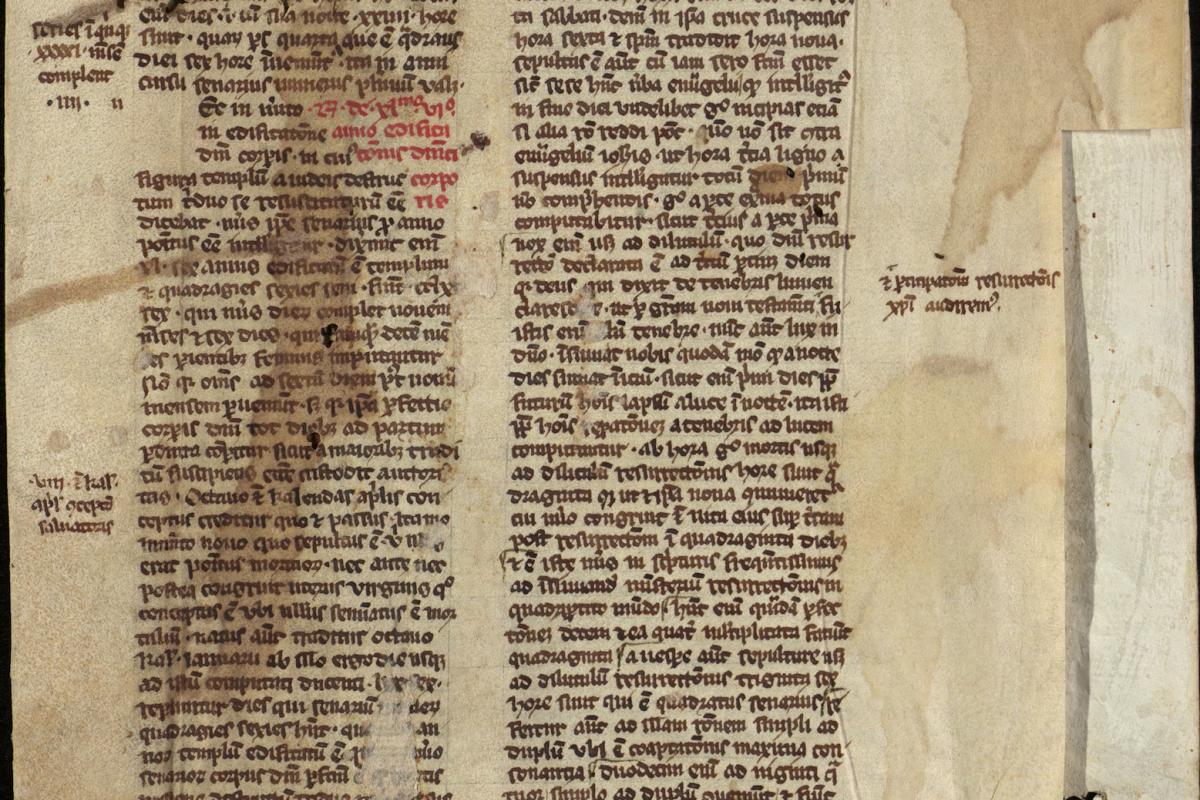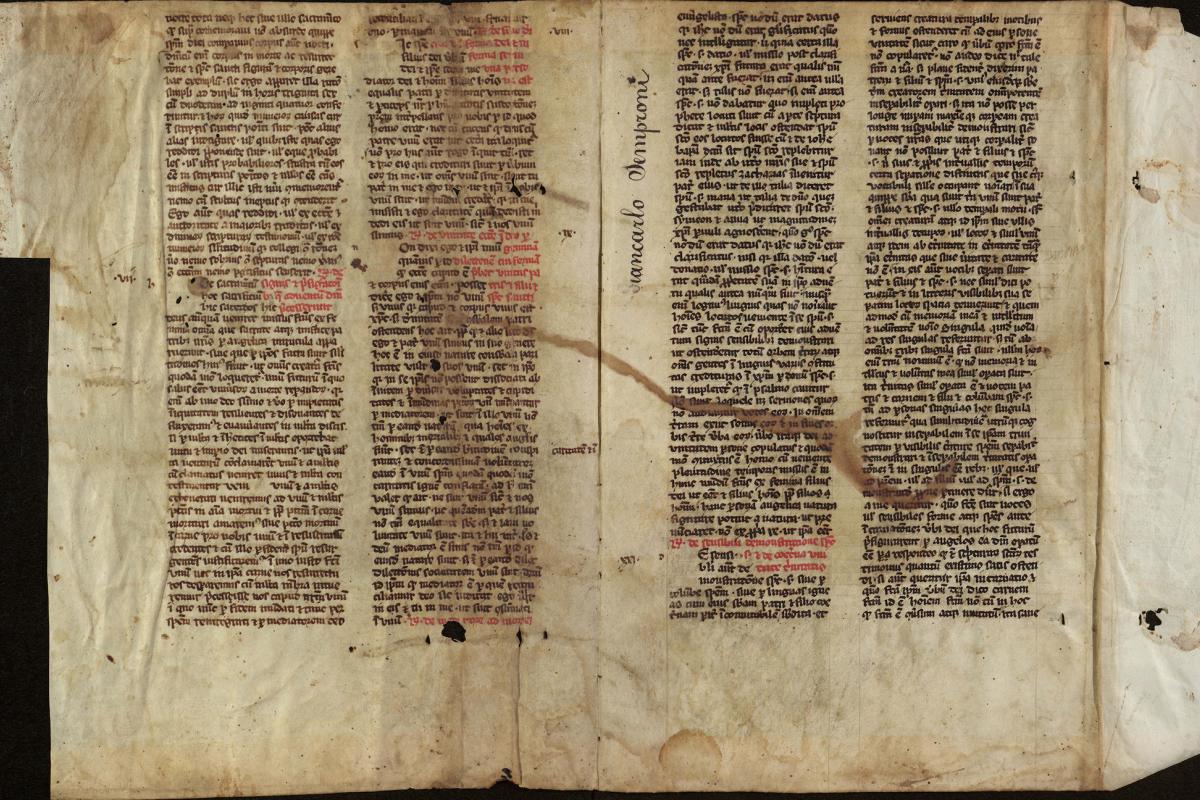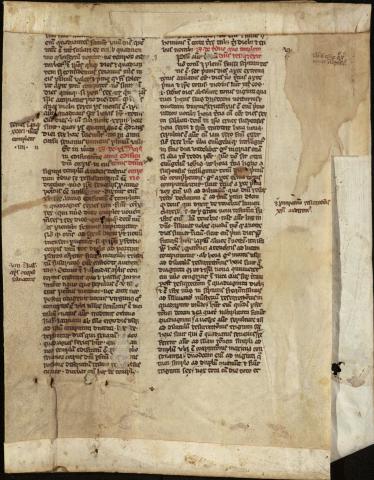De Trinitate Manuscript Leaf
De Trinitate Manuscript Leaf
Italian, 13th-14th century
Language: Latin
Single leaf: Book IV, chapters 8-13; 29-V
ink on vellum
height 32.5 cm
width 22.5 cm
Portland State University Library Special Collections
Mss. 10. Rose-Wright Manuscript Collection, no. 2
Victor Soares, Medieval Portland Capstone Student, Winter 2005
This manuscript leaf contains text from Saint Augustine's De Trinitate (On the Trinity), Book IV, chapter 8-13. It was produced in Italy in the 13th or 14th century. The leaf contains four pages of text, two pages on each side. The text is organized into two columns per page with about fifty-one lines of text per column. The guidelines used by the scribe are still visible. The text is written in faded black ink with a few lines of text written in red ink. There are various glosses (margin notes) on all four pages. On the left-hand margin of the third page, the name Siancarlo Semproni is written. An interesting attribute of this leaf is that the initial capitals are all missing despite there being a place reserved for them, suggesting that this manuscript leaf was never fully completed. Because the manuscript leaf has been folded into the shape of a book cover, perhaps it was used to either cover a book or serve as a middle layer between the leather cover of a book and its wood backing.
While De Trinitate is not one of Saint Augustine's more famous works, two hundred thirty-three manuscripts of it have been found dating from the ninth to the fifteenth century. It is believed that Saint Augustine first started writing the work around the year 400 and completed it in 416. In Book IV, the text of which appears in this manuscript leaf, Saint Augustine comments on the equality between the three parts of the Trinity and argues that the Son and the Holy Spirit and not inferior to God. Throughout the text he uses scriptural references to support his argument and relates ideas to the culture of his time.
Suggestions for further reading:
McKenna, Stephen, C.SS.R. The Fathers of the Church, Volume 45. pp. vii-xvi, Pg. 145-155
Wilma Fitzgerald, PhD, SP - Quoted with permission from an unpublished study
Aurelius Augustinus, De trinitate Lib. IV, c. 8-13; 19-V, 1. 13th/ 14th century. Vellum bifolium 325 x 220-225 (218-133) mm., two columns, 51 lines. Formerly used as a book cover. Folded at top, bottom and sides. Modern foliation: 40 and 41 is inaccurate because of the lacuna. Chapter titles in red. Initials never supplied although key letters are given. A strip (216 x 24 mm.) has been cut from right edge [folio 40]. In the center margin [folio 41] in dark script the name: Giancarlo Semproni. Lacuna of two folios (L. IV, c. 13-29). At the bottom of the recto of the second folio a book dealer's notation [Pirages of McMinnville, Oregon]: 54440. See: Sancti Aurelii Augustini De Trinitate Liber XV in Corpus Christianorum Series Latina Vol. 50 edited by W. J. Mountain and Fr. Glorie. page 171 line 54-178 line 22 and pages 200 line 24-206 line 25. (Turnholt 1968)
[f. 40] // [ Sed quoniam sicut mensem circuitus lunae osten]dit hominibus sic annus circuitu solis animadversus est restant autem quinque dies et quadrans diei ut sol impleat cursum suum annum que concludat .../... in me ut fuit consummati in umum [lacuna cap. 13-29] [f. 41] // [ad eum refertur a quo natus est filius et quod dicit] euangelista spiritus nodum erat datus Ihesus nondum erat glorificatus ...Explicit liber iiii incipit v qui iam in sequentibus libris disputentus et maxime in proximis talia sunt ut si aliquantam dya lector attulerit multum pronunicat si uero ea intelligendo laboret queritur quia modeste ac sobrie debeat homo cui etiam sue mentis natura in explicatione est de dei cogitare. [Lib. V] Hinc iam exordiens ea dicere .../... nos ipsi in interiore homine sumus scientia comprehendendes laboremus nec sufficiamus non tamen impudenter in [illa quae super sunt diuina] //




